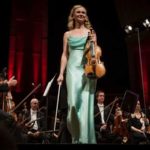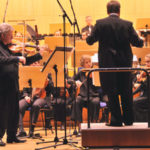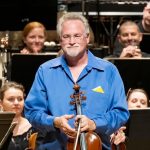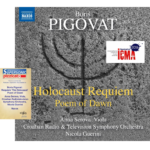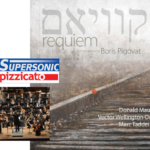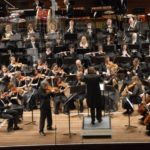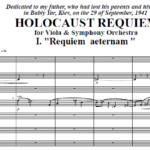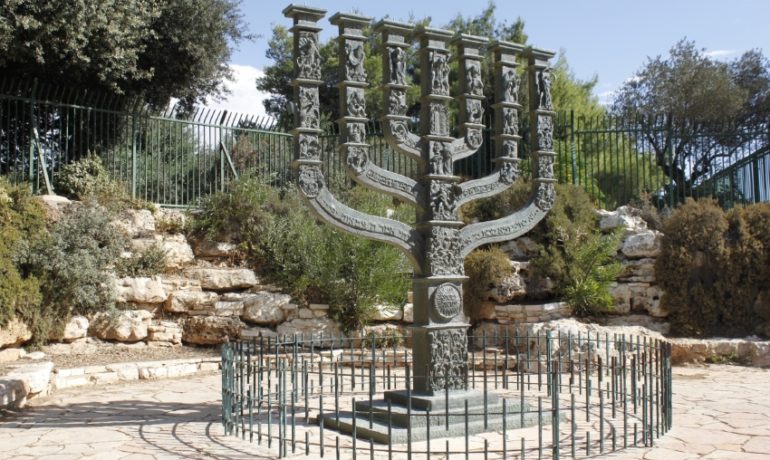
Tag: viola

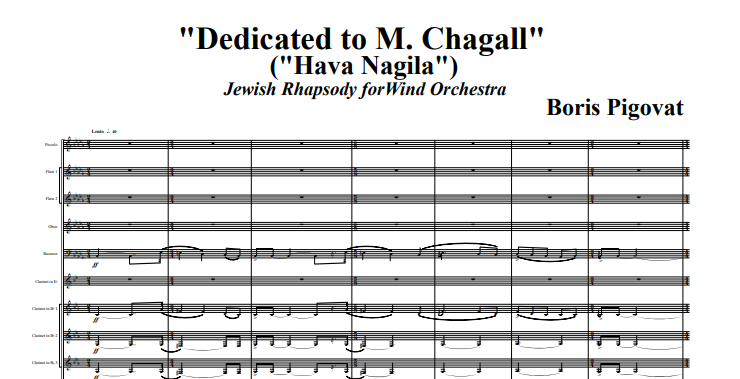
“Dedicated to Marc Chagall” (“Hava Nagila”)
Jewish Rhapsody for Wind Orchestra / String Orchestra (with Optional Piano) / Brass Ensemble / Saxophone Quartet / Solo Bayan
- Duration: ca. 9 minutes
My work Dedicated to Marc Chagall is based on the popular Jewish song Hava Nagila, which means Let us rejoice.
I had originally intended to write a rhapsody based on Hava Nagila, but I found myself writing episodes that were not derived from Hava Nagila. Suddenly, I realized that I was actually composing a tone poem, evoking scenes of a small Jewish town at the beginning of the 20th century. Such images and moods typify novels by Shalom Aleichem and the earlier paintings by Marc Chagall. I felt a particularly strong association to Chagall’s pictures. For this reason, I named the piece Dedicated to Marc Chagall, in addition to the secondary title of Jewish Rhapsody “Hava Nagila”.
I composed the piece in 2003, for wind orchestra, and then for string orchestra (with optional piano). The main part of both versions is similar, but the nature of strings required a completely different introduction for the string version.
The wind orchestra version premiered in 2003, performed by the Petach-Tikva Conservatoire Symphonic Band at Festival Kfar-Saba (in Israel), and conducted by Michael Delman.
The premiere of the string-orchestra was in 2005, performed by the Ramat Gan Chamber Orchestra (in Israel), and conducted by Aviv Ron.
Later, both versions were performed many times in Israel and around the world.
In 2015, the wind-orchestra version was also performed at the WASBE Conference in San Jose, California, by the Israel Youth Wind Orchestra, conducted by Motti Miron. Unfortunately, I don’t have a recording of that performance. However, below is the recording of a different performance of theirs, in Israel, in 2012:
In 2005, I was contacted by the Brandt-Brass Ensemble from Saratov, Russia. They sough a challenging piece to perform for international competition, and I prepared for them a version of Dedicated to Marc Chagall for brass ensemble.
In 2015, I also prepared a version for saxophone quartet; below is recording of that version performed by the Mestizo Saxophone Quartet, in 2018:
In 2012, I received an unexpected application from Ukrainian accordionist Pavel Fenyuk, asking for my permission to write an arrangement of the piece for solo bayan (chromatic button accordion). Below, is his virtuoso performance of that version:
The piece has already seen many variations, and who knows where else it will go?

2013: Sonata for Viola and Piano - International Viola Congress at Krakow and "home is where..." CD
- Duration: ca. 26 minutes
I composed Sonata for Viola and Piano in 2012 for violist Donald Maurice, after his great performance of the Holocaust Requeim at the Concert of Remembrance of 70th Anniversary of Kristallnacht in Wellington, New Zealand, in 2008.
The piece was conceived for the Home is where… CD launched by Atoll (New Zealand), and starring Donald Maurice and Richard Mapp.
Donald premiered this piece in 2013 at the International Viola Congress, in Krakow, Poland, with pianist Wioletta Fluda.
The Atoll CD was released that same year.
Later, in February and March 2015, the piece was performed at three concerts in the United States:
The American premiere was in Baltimore, featuring soloists Peter Minkler (viola) and Lura Johnson (piano).
Eight days later, in Houston featuring Lawrence Wheeler (viola) and Tali Morgulis (piano).
In March 2015, in Walden, Colorado, featuring Barbara Sudweeks (viola) and Jo Boatright (piano).
The first movement of Sonata was influenced by the strong emotional impact of two paintings: Sandro Botticelli’s Madonna del Magnificat (1483-1485) and и Madonna della Melagrana (Virgin with a Pomegranate) (1487).
While working on Sonata, I had an idea that it could also be performed as standalone piece; I named this piece Botticelli’s Magnificat.
I shared my idea with Donald and received his support. Donald premiered Botticelli’s Magnificat before the premiere of Sonata.
In 2013, this piece was performed by the young Israeli violist Matan Noussimovich (you can listen to the recording, below).
Below are some samples from the Home is where… CD and recordings from the U.S. premiere, and of Botticelli’s Magnificat.
Recording from the U.S. premiere in Baltimore, featuring Peter Minkler (viola) and Lura Johnson (piano)
Recording from the performance of Botticelli's Magnificat, featuring Matan Noussimovich (viola) and Pazit Gal (piano)
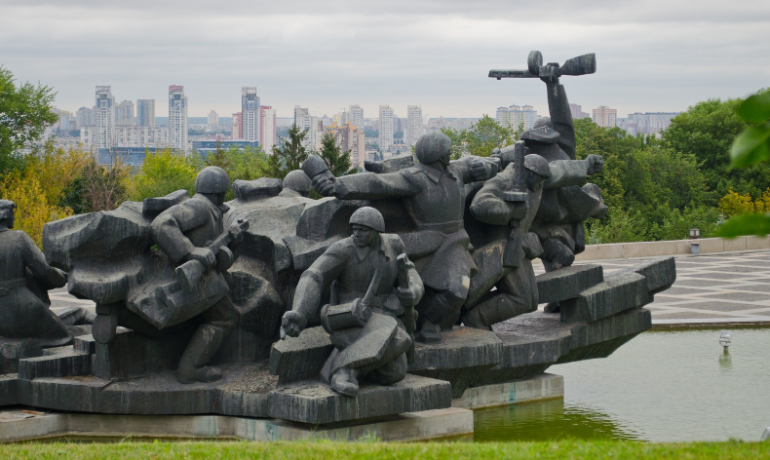
Symphony No.1 "Memorial" (1984; revised in 1987)
- Duration: ca. 28 minutes
- 3 Fls (Picc), 2 Obs (E.Hn), 3 Cls (B.Cl), 2 Bsns, 4 Hns, 3 Tpts, 3 Tbns, Tuba, Timp, Perc (4), Cel, Hp, Str.
The Memorial symphony is dedicated to the victims of World War II, a theme that touched me personally.
I was very excited for the composition’s premiere to be performed by the USSR Symphony Cinema Orchestra, in 1988, in Moscow. For a young composer, this was an amazing opportunity. Plus, this was the first time that I heard the symphony performed live, and it was also recorded — by the best orchestra I could have wished for at that time.
Below, is the live recording of the premiere. The recording is old, and there are some background noises, so please accept my apology for that.
The Ministry of Movies Industry Symphony Orchestra, Moscow
Emin Khachaturian, Conductor
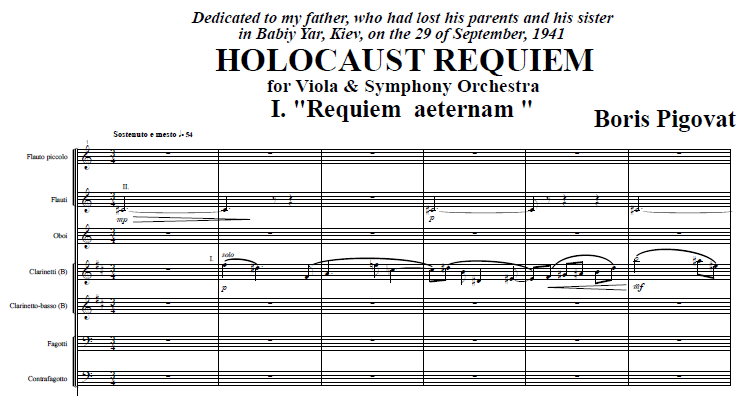
Holocaust Requiem for Viola and Symphony Orchestra (1994-1995)
- Duration: ca. 46 minutes
- 3 Fls (Picc), 2 Obs, 3 Cls (B.Cl) 2 Bsns, C.Bn, 4 Hns, 3 Tpts, 3 Tbns, Tba, Timp, Perc (4), Cel, Pno, Hp, Vla solo, Str.
For years, I felt the necessity to write a work dedicated to the Holocaust. After my immigration to Israel I started to consider different ideas for such a work. At first, I wanted to write a requiem for the standard orchestration: soloists, choir, orchestra and, maybe, narrator. At that time, Yuri Gandelsman, the principal violist of the Israel Philharmonic Orchestra, asked me to write something for him. He was an excellent violist whom I had known for years – we learned at the same time at Gnessin College and then at Gnessin Institute (Academy of Music). So, when he asked me to write for him a work for viola and symphony orchestra, I suddenly understood – I would write a requiem for viola and symphony orchestra! I would write the work without the text, without the choir and solo singers, but I would try to save the tragic atmosphere of a traditional requiem.
I dedicated Requiem to my father, whose family was murdered in Babi Yar by Nazis in September of 1941. It took me about two years to write it, during which I felt that he was waiting for me to complete it. The day after I finished writing Requiem, my father passed away.
In the end, Yuri Gandelsman did not perform Requiem.
In October 1995, less than a year after it’s composition, Requiem received the ACUM (Israeli ASCAP) award.
The world premiere of Requiem took place in October 2001, at the memorial evening dedicated to Babi Yar tragedy, in Kiev, by remarkable violist Rainer Moog and the Symphony Orchestra of National Philarmonic Society of Ukraine, conducted by Roman Kofman.
Requiem was performed again seven years later at the Concert of Remembrance for the 70th Anniversary of Kristallnacht, at an outstanding performance by Donald Maurice and the Vector Wellington Orchestra in New Zealand, conducted by Marc Taddei. Later, a live recording was released by Atoll with three more of my pieces.
After listening for the Kiev recording of Requiem, violist Anna Serova and conductor Nicola Guerini pushed Naxos to record Requiem. The Naxos compilation includes another piece that I wrote for Anna: Poem of Dawn for Viola and Symphony Orchestra.
Both the Atoll CD (in 2011) and the Naxos CD (in 2015) received Pizzicato’s Supersonic Award, and the Naxos CD was also nominated for the 2016 ICMA award.
In 2021, Professor Maurice and his PhD student Xi (Lucy) Liu produced a film Lacrimosa Dies Illa, which is based on Requiem, as Lucy’s PhD research. The film premiere took place in Wellington’s Penthouse Cinema in May 2021.
Click here for more information about this documentary. The film itself is available online here (the trailer can be found here).
In September 2023, the US premiere of Holocaust Requiem took place in Annapolis by Peter Minkler and Annapolis Symphony Orchestra, conducted by José-Luis Novo.
I am honored to have such wonderful performers for the piece!
Below is a live recording of the outstanding premiere performed in Kiev and few samples from a performance in Wellington. Additional recordings and information about Requiem performances can be found in my website by using the SEARCH widget from the main menu or the sidebar (type requiem).
Recording from Memorial Evening dedicated to Babi Yar tradegy in Kiev, 2001
Rainer Moog, Viola
Roman Kofman, Conductor
Symphony Orchestra National Philarmonic Society of Ukraine
Samples from recording from Concert of Remenbrance for Kristallnacht Anniversary in Wellington, 2008
Donald Maurice, Viola
Marc Taddei, Conductor
Vector Wellington Orchestra
Pigovat's Holocaust Requiem may prove to be one of the three finest masterpieces ever written for viola, with the Bartók and Walton Viola concertos. It now primarily needs time and exposure and to become known in contemporary 21st century literature.
